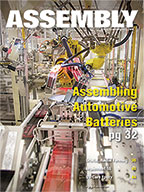In lean manufacturing, any activity that does not add value to an assembly is waste. Taken to an extreme, the time a pick-and-place mechanism spends moving a part could be considered waste. In that light, it's not surprising that electronics assemblers are equipping their lines with pick-and-place machines that can put down more than 30,000 cph.
To get such high rates, the placement head must get from the pick positions to the board very quickly. And, thanks to improvements in microprocessors, motors, bearings and feedback technology, it can. Today's linear motion systems can achieve speeds exceeding 2 meters per second. "We've done some applications that can go 4.5 meters per second, and we had one that had to go 9 meters per second," says Lee Stephens, an applications engineer with Danaher Motion (Radford, VA).
Linear motors and direct-drive rotary motors have played a key role in the development of high-speed motion systems. "The absence of mechanical reduction in these systems provides a 1-to-1 correlation between motor and load velocity," says Ron Rekowski, director of product marketing for laser and medical systems at Aerotech Inc. (Pittsburgh). "Higher voltage drives and alternate motor winding designs provide adequate bus voltage to overcome back electromotive force and develop torque in the motor."
If the application requires both high speed and high acceleration, a linear motor may be a better choice than a ballscrew or belt driven by a rotary motor. "There comes a point where you can't turn the ballscrew fast enough," says Stephens. "I've seen ballscrews work at speeds of 80 ips without too many problems, but that's pushing it. Above that, you're asking for trouble."
Along with the motor, virtually every other part of the system must be designed specifically for high-speed operation. The bearings must have adequate preload, and the data rate of the feedback device must be able to keep up with the speed of the motor. The machine structure should be stiff enough to handle the acceleration changes and vibrations associated with high speeds. The system may even need a special lubricant, such as Kluber or Anderol. "At high speeds, problems that you don't normally think about suddenly become real," warns Stephens.
Of course, a high-speed linear motion system is not necessarily better than a slower one, and the increase in throughput may not offset the extra expense of building and maintaining the system. The desirability of high-speed motion depends on many factors, including cost, throughput, floor space, quality and even power requirements.
Before specifying a system for high speeds, engineers should first ensure that the process they want to make faster warrants the effort and expense. For example, in a textile cutting application, actuator speed is limited by the need for a smooth cut. In an automated welding application, actuator speed is limited by the need for a good joint.
"If you're putting a bead weld on an airplane wing, I'm not so sure that it behooves you to go faster, if it creates quality problems," says Stephens. "You can't increase the speed of that process, for no other reason than it takes a certain amount of time to heat up the metal."
In some cases, the costs of high-speed motion may not be immediately apparent. Maintenance is a good example. "Say you have a machine that cuts 5,000 widgets per day," says Stephens. "If you can build a machine that cuts 10,000 widgets per day, will you double your money? Maybe not. You may end up spending more money on components and maintenance. The blades are running at higher speeds, which means they get dull faster. And it's not because they cut an extra 5,000 widgets, but because they are running hotter and they don't stay sharp as long. So now you have to replace four blades per day, when you used to replace one."






